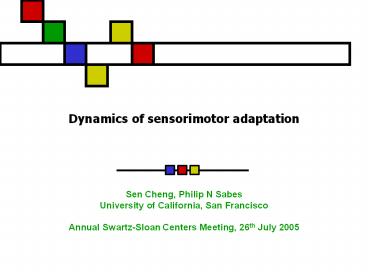Dynamics of sensorimotor adaptation - PowerPoint PPT Presentation
Title:
Dynamics of sensorimotor adaptation
Description:
Dynamics of sensorimotor adaptation. Sen Cheng, Philip N Sabes ... Anisotropy in learning and noise. 20. Conclusions. LDS are good models for adaptation dynamics ... – PowerPoint PPT presentation
Number of Views:31
Avg rating:3.0/5.0
Title: Dynamics of sensorimotor adaptation
1
Dynamics of sensorimotor adaptation
- Sen Cheng, Philip N Sabes
- University of California, San Francisco
- Annual Swartz-Sloan Centers Meeting, 26th July
2005
2
A simple sensorimotor task
3
Motivation and outline
- trial-by-trial dynamics
- What is the learning rule of adaptation?
- What signals drive learning?
- Noise in the learning process?
- Spatial anisotropies?
- More powerful correlation between behavior and
neural activity.
block design
- Steady-state of adaptation
- Compare average behavior pre- and post-exposure
4
Virtual reality setup
5
Concurrent test and exposure
6
Model for dynamics of adaptation
general state space model
- ut inputs (?)
- xt internal state, planned/expected reach error
- yt actual reach error
- qt learning noise
- rt motor noise
7
Questions
1. What signals drive learning? 2. Noise in the
learning process? 3. Spatial anisotropies?
8
Two candidate learning signals
- et visual error
- dt perturbation/ discrepancy betw. vision and
proprioception
Learning equation with two input signals
System identification with expectation-maximizatio
n (EM) algorithm, Cheng and Sabes, 2005, submitted
9
Sample data and vis-model fit
- perturbation
- reach error
- model prediction
10
Portmanteau test for serial autocorrelations
Is the sequence of residuals a
white noise sequence?
Portmanteau test for vis-model
11
pert-model fit to sample data
perturbation reach error vis-model pert-model
12
Portmanteau test cannot distinguish models
for vis-model
for pert-model
13
Likelihood ratio test (LRT) for nested models
M1 no input
M2 pert
M3 vis error
M4 pert and vis
14
Questions
1. What signals drive learning? 2. Noise in the
learning process? 3. Spatial anisotropies?
15
The signal that drives learning
pert-model
Estimated models
pert-model
vis-model
apply to no feedback (noFB) reaches
vis-model
16
Questions
1. What signals drive learning? ? 2. Noise in
the learning process? 3. Spatial anisotropies?
17
Learning noise
x
stochastic pert LRT (n18) p lt 10-4
noFB LRT (n18) p lt 0.0003
18
Questions
1. What signals drive learning? ? 2. Noise in
the learning process? ? 3. Spatial anisotropies?
19
Anisotropy in learning and noise
20
Conclusions
- LDS are good models for adaptation dynamics
- New insights into adaptation
- Visual error drives adaptation predominantly
- There is learning noise
- Dynamics are anisotropic
- Can now correlate trial-by-trial changes of
behavior with neural activity. - supported by the Swartz foundation































